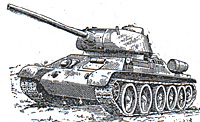 Having set the scene with a few pointers it is important to set something down in concrete. To that end, listed below are the three principles of armour. The aim of these principles is to give anyone facing an armour exam, or even just a stiff question, something to hang their hat on and guarantee a few points.
Having set the scene with a few pointers it is important to set something down in concrete. To that end, listed below are the three principles of armour. The aim of these principles is to give anyone facing an armour exam, or even just a stiff question, something to hang their hat on and guarantee a few points.
Here goes: The larger the tank the less room there is to stow personal kit. The smaller the tank the more it leaks. The longer the Infantry have a tank, the more likely it is to be broken.
Fairly simple, eh? Remember those and you can't go far wrong. You will, however, also hear the concept of crew fatigue bandied around, mostly by armoured sorts, as a planning principle for armour. I had better clear this up; although it sounds plausible it is, in fact, rubbish. The theory of crew fatigue is that tank crews get really tired while they rough it, more than anyone else can even imagine. The reality is that when it is cold they warm up on the back decks, fresh rations are stored in the side bins and they don't have to walk anywhere. Look inside a turret on a hot day and the commander is wearing nothing more than a crop-top (covering what sticks out of the turret), the loader will be in shorts and the gunner is probably naked.
A Short Guide to Armor Tanks and Techniques
Back to Table of Contents -- Lone Warrior # 149
Back to Lone Warrior List of Issues
Back to MagWeb Magazine List
© Copyright 2005 by Solo Wargamers Association.
This article appears in MagWeb.com (Magazine Web) on the Internet World Wide Web.
Other articles from military history and related magazines are available at http://www.magweb.com
